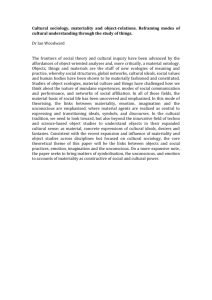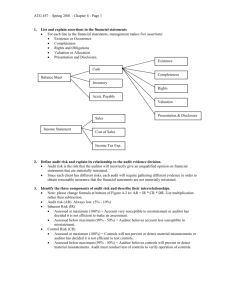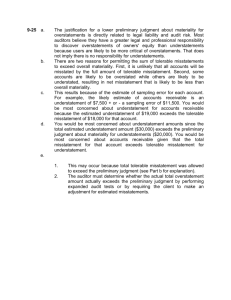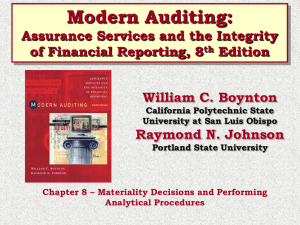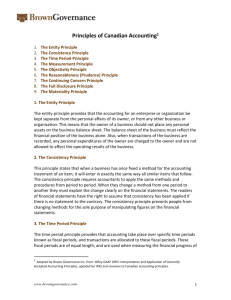conforming amendments as a result of ssa 320, materiality in
advertisement
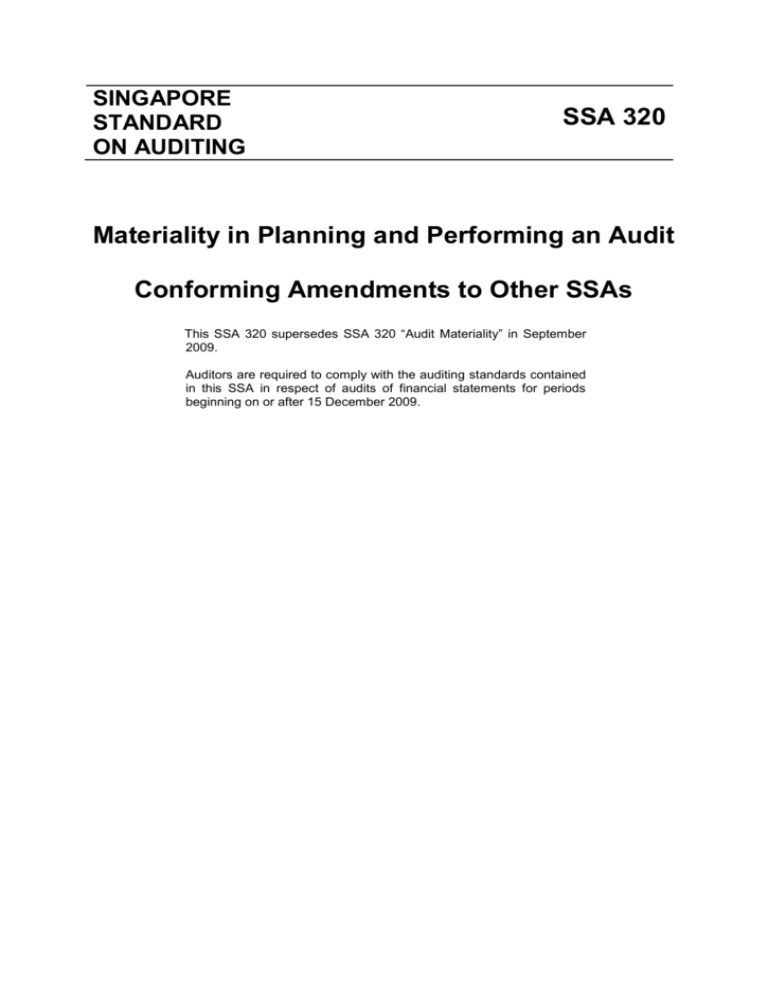
SINGAPORE STANDARD ON AUDITING SSA 320 Materiality in Planning and Performing an Audit Conforming Amendments to Other SSAs This SSA 320 supersedes SSA 320 “Audit Materiality” in September 2009. Auditors are required to comply with the auditing standards contained in this SSA in respect of audits of financial statements for periods beginning on or after 15 December 2009. SINGAPORE STANDARD ON AUDITING 320 MATERIALITY IN PLANNING AND PERFORMING AN AUDIT (Effective for audits of financial statements for periods beginning on or after 15 December 2009) CONTENTS Paragraph Foreword Introduction Scope of this SSA 1 Materiality in the Context of an Audit 2−6 Effective Date 7 Objective 8 Definition 9 Requirements Determining Materiality and Performance Materiality When Planning the Audit 10−11 Revision as the Audit Progresses 12−13 Documentation 14 Application and Other Explanatory Material Materiality and Audit Risk A1 Determining Materiality and Performance Materiality When Planning the Audit Revision as the Audit Progresses A2−A12 A13 Singapore Standard on Auditing (SSA) 320, “Materiality in Planning and Performing an Audit” should be read in the context of SSA 200, “Overall Objectives of the Independent Auditor and the Conduct of an Audit in Accordance with Singapore Standards on Auditing.” 2 SINGAPORE STANDARD ON AUDITING SSA 320 Foreword This Standard is based on International Standard on Auditing 320. Introduction Scope of this SSA 1. This Singapore Standard on Auditing (SSA) deals with the auditor’s responsibility to apply the concept of materiality in planning and performing an audit of financial statements. SSA 4501 explains how materiality is applied in evaluating the effect of identified misstatements on the audit and of uncorrected misstatements, if any, on the financial statements. Materiality in the Context of an Audit 2. Financial reporting frameworks often discuss the concept of materiality in the context of the preparation and presentation of financial statements. Although financial reporting frameworks may discuss materiality in different terms, they generally explain that: • Misstatements, including omissions, are considered to be material if they, individually or in the aggregate, could reasonably be expected to influence the economic decisions of users taken on the basis of the financial statements; • Judgments about materiality are made in light of surrounding circumstances, and are affected by the size or nature of a misstatement, or a combination of both; and • Judgments about matters that are material to users of the financial statements are based on a consideration of the common financial information needs of users as a group.2 The possible effect of misstatements on specific individual users, whose needs may vary widely, is not considered. 3. Such a discussion, if present in the applicable financial reporting framework, provides a frame of reference to the auditor in determining materiality for the audit. If the applicable financial reporting framework does not include a discussion of the concept of materiality, the characteristics referred to in paragraph 2 provide the auditor with such a frame of reference. 4. The auditor’s determination of materiality is a matter of professional judgment, and is affected by the auditor’s perception of the financial information needs of users of the financial statements. In this context, it is reasonable for the auditor to assume that users: (a) 1 2 Have a reasonable knowledge of business and economic activities and accounting and a willingness to study the information in the financial statements with reasonable diligence; SSA 450, “Evaluation of Misstatements Identified during the Audit.” For example, the “Framework for the Preparation and Presentation of Financial Statements,” adopted by the Accounting Standard Council (ASC) , indicates that, for a profit-oriented entity, as investors are providers of risk capital to the enterprise, the provision of financial statements that meet their needs will also meet most of the needs of other users that financial statements can satisfy. 3 (b) Understand that financial statements are prepared, presented and audited to levels of materiality; (c) Recognize the uncertainties inherent in the measurement of amounts based on the use of estimates, judgment and the consideration of future events; and (d) Make reasonable economic decisions on the basis of the information in the financial statements. 5. The concept of materiality is applied by the auditor both in planning and performing the audit, and in evaluating the effect of identified misstatements on the audit and of uncorrected misstatements, if any, on the financial statements and in forming the opinion in the auditor’s report. (Ref: Para. A1) 6. In planning the audit, the auditor makes judgments about the size of misstatements that will be considered material. These judgments provide a basis for: (a) Determining the nature, timing and extent of risk assessment procedures; (b) Identifying and assessing the risks of material misstatement; and (c) Determining the nature, timing and extent of further audit procedures. The materiality determined when planning the audit does not necessarily establish an amount below which uncorrected misstatements, individually or in the aggregate, will always be evaluated as immaterial. The circumstances related to some misstatements may cause the auditor to evaluate them as material even if they are below materiality. Although it is not practicable to design audit procedures to detect misstatements that could be material solely because of their nature, the auditor considers not only the size but also the nature of uncorrected misstatements, and the particular circumstances of their occurrence, when evaluating their effect on the financial statements.3 Effective Date 7. This SSA is effective for audits of financial statements for periods beginning on or after 15 December 2009. Objective 8. The objective of the auditor is to apply the concept of materiality appropriately in planning and performing the audit. Definition 9. 3 For purposes of the SSAs, performance materiality means the amount or amounts set by the auditor at less than materiality for the financial statements as a whole to reduce to an appropriately low level the probability that the aggregate of uncorrected and undetected misstatements exceeds materiality for the financial statements as a whole. If applicable, performance materiality also refers to the amount or amounts set by the auditor at less than the materiality level or levels for particular classes of transactions, account balances or disclosures. SSA 450, paragraph A16. 4 Requirements Determining Materiality and Performance Materiality When Planning the Audit 10. When establishing the overall audit strategy, the auditor shall determine materiality for the financial statements as a whole. If, in the specific circumstances of the entity, there is one or more particular classes of transactions, account balances or disclosures for which misstatements of lesser amounts than materiality for the financial statements as a whole could reasonably be expected to influence the economic decisions of users taken on the basis of the financial statements, the auditor shall also determine the materiality level or levels to be applied to those particular classes of transactions, account balances or disclosures. (Ref: Para. A2-A11) 11. The auditor shall determine performance materiality for purposes of assessing the risks of material misstatement and determining the nature, timing and extent of further audit procedures. (Ref: Para. A12) Revision as the Audit Progresses 12. The auditor shall revise materiality for the financial statements as a whole (and, if applicable, the materiality level or levels for particular classes of transactions, account balances or disclosures) in the event of becoming aware of information during the audit that would have caused the auditor to have determined a different amount (or amounts) initially. (Ref: Para. A13) 13. If the auditor concludes that a lower materiality for the financial statements as a whole (and, if applicable, materiality level or levels for particular classes of transactions, account balances or disclosures) than that initially determined is appropriate, the auditor shall determine whether it is necessary to revise performance materiality, and whether the nature, timing and extent of the further audit procedures remain appropriate. Documentation 14. The auditor shall include in the audit documentation the following amounts and the factors considered in their determination:4 (a) Materiality for the financial statements as a whole (see paragraph 10); (b) If applicable, the materiality level or levels for particular classes of transactions, account balances or disclosures (see paragraph 10); (c) Performance materiality (see paragraph 11); and (d) Any revision of (a)-(c) as the audit progressed (see paragraphs 12-13). *** 4 SSA 230, “Audit Documentation,” paragraphs 8-11, and A6. 5 Application and Other Explanatory Material Materiality and Audit Risk (Ref: Para. 5) A1. In conducting an audit of financial statements, the overall objectives of the auditor are to obtain reasonable assurance about whether the financial statements as a whole are free from material misstatement, whether due to fraud or error, thereby enabling the auditor to express an opinion on whether the financial statements are prepared, in all material respects, in accordance with an applicable financial reporting framework; and to report on the financial statements, and communicate as required by the SSAs, in accordance with the auditor’s findings.5 The auditor obtains reasonable assurance by obtaining sufficient appropriate audit evidence to reduce audit risk to an acceptably low level. 6 Audit risk is the risk that the auditor expresses an inappropriate audit opinion when the financial statements are materially misstated. Audit risk is a function of the risks of material misstatement and detection risk.7 Materiality and audit risk are considered throughout the audit, in particular, when: (a) Identifying and assessing the risks of material misstatement;8 (b) Determining the nature, timing and extent of further audit procedures; 9 and (c) Evaluating the effect of uncorrected misstatements, if any, on the financial statements 10 and in forming the opinion in the auditor’s report.11 Determining Materiality and Performance Materiality When Planning the Audit Considerations Specific to Public Sector Entities (Ref: Para. 10) A2. In the case of a public sector entity, legislators and regulators are often the primary users of its financial statements. Furthermore, the financial statements may be used to make decisions other than economic decisions. The determination of materiality for the financial statements as a whole (and, if applicable, materiality level or levels for particular classes of transactions, account balances or disclosures) in an audit of the financial statements of a public sector entity is therefore influenced by law, regulation or other authority, and by the financial information needs of legislators and the public in relation to public sector programs. Use of Benchmarks in Determining Materiality for the Financial Statements as a Whole (Ref: Para. 10) A3. Determining materiality involves the exercise of professional judgment. A percentage is often applied to a chosen benchmark as a starting point in determining materiality for the financial statements as a whole. Factors that may affect the identification of an appropriate benchmark include the following: • The elements of the financial statements (for example, assets, liabilities, equity, revenue, expenses); • Whether there are items on which the attention of the users of the particular entity’s financial statements tends to be focused (for example, for the purpose of evaluating financial performance users may tend to focus on profit, revenue or net assets); SSA 200, “Overall Objectives of the Independent Auditor and the Conduct of an Audit in Accordance with Singapore Standards on Auditing,” paragraph 11. 6 SSA 200, paragraph 17. 7 SSA 200, paragraph 13(c). 8 SSA 315, “Identifying and Assessing the Risks of Material Misstatement through Understanding the Entity and Its Environment.” 9 SSA 330, “The Auditor’s Responses to Assessed Risks.” 10 SSA 450. 11 SSA 700, “Forming an Opinion and Reporting on Financial Statements.” 5 6 • The nature of the entity, where the entity is in its life cycle, and the industry and economic environment in which the entity operates; • The entity’s ownership structure and the way it is financed (for example, if an entity is financed solely by debt rather than equity, users may put more emphasis on assets, and claims on them, than on the entity’s earnings); and • The relative volatility of the benchmark. A4. Examples of benchmarks that may be appropriate, depending on the circumstances of the entity, include categories of reported income such as profit before tax, total revenue, gross profit and total expenses, total equity or net asset value. Profit before tax from continuing operations is often used for profit-oriented entities. When profit before tax from continuing operations is volatile, other benchmarks may be more appropriate, such as gross profit or total revenues. A5. In relation to the chosen benchmark, relevant financial data ordinarily includes prior periods’ financial results and financial positions, the period-to-date financial results and financial position, and budgets or forecasts for the current period, adjusted for significant changes in the circumstances of the entity (for example, a significant business acquisition) and relevant changes of conditions in the industry or economic environment in which the entity operates. For example, when, as a starting point, materiality for the financial statements as a whole is determined for a particular entity based on a percentage of profit before tax from continuing operations, circumstances that give rise to an exceptional decrease or increase in such profit may lead the auditor to conclude that materiality for the financial statements as a whole is more appropriately determined using a normalized profit before tax from continuing operations figure based on past results. A6. Materiality relates to the financial statements on which the auditor is reporting. Where the financial statements are prepared for a financial reporting period of more or less than twelve months, such as may be the case for a new entity or a change in the financial reporting period, materiality relates to the financial statements prepared for that financial reporting period. A7. Determining a percentage to be applied to a chosen benchmark involves the exercise of professional judgment. There is a relationship between the percentage and the chosen benchmark, such that a percentage applied to profit before tax from continuing operations will normally be higher than a percentage applied to total revenue. For example, the auditor may consider five percent of profit before tax from continuing operations to be appropriate for a profit-oriented entity in a manufacturing industry, while the auditor may consider one percent of total revenue or total expenses to be appropriate for a not-for-profit entity. Higher or lower percentages, however, may be deemed appropriate in the circumstances. Considerations Specific to Small Entities A8. When an entity’s profit before tax from continuing operations is consistently nominal, as might be the case for an owner-managed business where the owner takes much of the profit before tax in the form of remuneration, a benchmark such as profit before remuneration and tax may be more relevant. Considerations Specific to Public Sector Entities A9. In an audit of a public sector entity, total cost or net cost (expenses less revenues or expenditure less receipts) may be appropriate benchmarks for program activities. Where a public sector entity has custody of public assets, assets may be an appropriate benchmark. 7 Materiality Level or Levels for Particular Classes of Transactions, Account Balances or Disclosures (Ref: Para. 10) A10. A11. Factors that may indicate the existence of one or more particular classes of transactions, account balances or disclosures for which misstatements of lesser amounts than materiality for the financial statements as a whole could reasonably be expected to influence the economic decisions of users taken on the basis of the financial statements include the following: • Whether law, regulation or the applicable financial reporting framework affect users’ expectations regarding the measurement or disclosure of certain items (for example, related party transactions, and the remuneration of management and those charged with governance). • The key disclosures in relation to the industry in which the entity operates (for example, research and development costs for a pharmaceutical company). • Whether attention is focused on a particular aspect of the entity’s business that is separately disclosed in the financial statements (for example, a newly acquired business). In considering whether, in the specific circumstances of the entity, such classes of transactions, account balances or disclosures exist, the auditor may find it useful to obtain an understanding of the views and expectations of those charged with governance and management. Performance Materiality (Ref: Para. 11) A12. Planning the audit solely to detect individually material misstatements overlooks the fact that the aggregate of individually immaterial misstatements may cause the financial statements to be materially misstated, and leaves no margin for possible undetected misstatements. Performance materiality (which, as defined, is one or more amounts) is set to reduce to an appropriately low level the probability that the aggregate of uncorrected and undetected misstatements in the financial statements exceeds materiality for the financial statements as a whole. Similarly, performance materiality relating to a materiality level determined for a particular class of transactions, account balance or disclosure is set to reduce to an appropriately low level the probability that the aggregate of uncorrected and undetected misstatements in that particular class of transactions, account balance or disclosure exceeds the materiality level for that particular class of transactions, account balance or disclosure. The determination of performance materiality is not a simple mechanical calculation and involves the exercise of professional judgment. It is affected by the auditor’s understanding of the entity, updated during the performance of the risk assessment procedures; and the nature and extent of misstatements identified in previous audits and thereby the auditor’s expectations in relation to misstatements in the current period. Revision as the Audit Progresses (Ref: Para. 12) A13. Materiality for the financial statements as a whole (and, if applicable, the materiality level or levels for particular classes of transactions, account balances or disclosures) may need to be revised as a result of a change in circumstances that occurred during the audit (for example, a decision to dispose of a major part of the entity’s business), new information, or a change in the auditor’s understanding of the entity and its operations as a result of performing further audit procedures. For example, if during the audit it appears as though actual financial results are likely to be substantially different from the anticipated period end financial results that were used initially to determine materiality for the financial statements as a whole, the auditor revises that materiality. 8 CONFORMING AMENDMENTS AS A RESULT OF SSA 320, MATERIALITY IN PLANNING AND PERFORMING AN AUDIT SSA 230, “Audit Documentation” A17. Examples of matters that may be documented together in the audit of a smaller entity include the understanding of the entity and its internal control, the overall audit strategy and audit plan, materiality determined in accordance with SSA 320,1 assessed risks, significant matters noted during the audit, and conclusions reached. SSA 260, “Communication with Those Charged with Governance” A15. Communication regarding the planned scope and timing of the audit may: (a) A17. Assist those charged with governance to understand better the consequences of the auditor’s work, to discuss issues of risk and the concept of materiality with the auditor, and to identify any areas in which they may request the auditor to undertake additional procedures … Matters communicated may include: … • The application of the concept of materiality in the context of an audit. SSA 300, “Planning an Audit of Financial Statements” Appendix Considerations in Establishing the Overall Audit Strategy Significant Factors, Preliminary Engagement Activities, and Knowledge Gained on Other Engagements • The determination of appropriate materiality levels in accordance with SSA 320,2 and, where applicable including: o Setting materiality for planning purposes. o Setting Determination of materiality for components and communicating materiality for thereof to component auditors of components in accordance with SSA 600.3 o Reconsidering materiality as audit procedures are performed during the course of the audit. o Preliminary identification of material significant components and material classes of transactions, account balances and disclosures. SSA 315, “Identifying and Assessing the Risks of Material Misstatement Through Understanding the Entity and Its Environment” 1 2 3 SSA 320, “Materiality in Planning and Performing an Audit.” SSA 320, “Materiality in Planning and Performing an Audit.” SSA 600, “Special Considerations—Audits of Group Financial Statements (Including the Work of Component Auditors),” paragraphs 21-23 and 40(c). 9 A1. … The understanding establishes a frame of reference within which the auditor plans to audit and exercise professional judgment throughout the audit, for example, when: … • Establishing Determining materiality in accordance with SSA 320 and evaluating whether the judgment about materiality remains appropriate as the audit progresses;4 … SSA 540, “Auditing Accounting Estimates, Including Fair Value Accounting Estimates, and Related Disclosures” A94. Ordinarily, a range that has been narrowed to be equal to or less than the amount lower than the materiality level for the financial statements as a whole determined for purposes of assessing risks of material misstatement, and designing further audit procedures performance materiality is adequate for the purposes of evaluating the reasonableness of management’s point estimate … A122. The auditor’s evaluation of the adequacy of disclosure of estimation uncertainty increases in importance the greater the range of possible outcomes of the accounting estimate is in relation to materiality (see related discussion in paragraph A9594). SSA 600, “Special Considerations—Audits of Group Financial Statements (Including the Work of Component Auditors)” 9. For purposes of the SSAs, the following terms have the meanings attributed below: … (d) 21. 22. 4 Component materiality – The materiality level for a component determined by the group engagement team … The group engagement team shall determine the following: (Ref: Para. A42) (a) The mMateriality level for the group financial statements as a whole when establishing the overall group audit strategy. (b) Whether, If, in the specific circumstances of the group, there are particular classes of transactions, account balances or disclosures in the group financial statements for which misstatements of lesser amounts than the materiality level for the group financial statements as a whole could reasonably be expected to influence the economic decisions of users taken on the basis of the group financial statements. In such circumstances, the group engagement team shall determine the materiality level or levels to be applied to those particular classes of transactions, account balances or disclosures. (c) Component materiality for those components where component auditors will perform an audit or a review for purposes of the group audit. To reduce to an appropriately low level the risk probability that the aggregate of detected uncorrected and undetected misstatements in the group financial statements exceeds the materiality level for the group financial statements as a whole, component materiality shall be lower than the materiality level for the group financial statements as a whole. (Ref: Para. A43-A44) (d) The threshold above which misstatements cannot be regarded as clearly trivial to the group financial statements. (Ref: Para. A45) Where component auditors will perform an audit for purposes of the group audit, the group engagement team shall evaluate the appropriateness of the amount or amounts lower than the component materiality level (and the amount or amounts lower than the materiality level SSA 320, “Materiality in Planning and Performing an Audit.” 10 for particular classes of transactions, account balances or disclosures, if applicable) performance materiality determined for purposes of assessing the risks of material misstatement and designing further audit procedures to respond to assessed risks at the component level. (Ref: Para. A46) 23. When a component is subject to audit by statute, regulation or other reason, and the group engagement team decides to use that audit to provide audit evidence for the group audit, the group engagement team shall determine whether: (a) the materiality level determined for the component financial statements as a whole; and (b) the lower amounts determined for purposes of assessing the risks of material misstatement and designing further audit procedures to respond to assessed risks performance materiality at the component level meet the requirements of this SSA. 40. The group engagement team shall communicate its requirements to the component auditor on a timely basis. This communication shall set out the work to be performed, the use to be made of that work, and the form and content of the component auditor’s communication with the group engagement team. (Ref: Para. A57, A58, A60) It shall also include the following: … (c) In the case of an audit or review of the financial information of the component, component materiality (and, if applicable, the amount or amounts lower than the materiality level or levels for particular classes of transactions, account balances or disclosures, if applicable) and the threshold above which misstatements cannot be regarded as clearly trivial to the group financial statements … A42. The auditor is required: (a) When establishing the overall audit strategy, to determine: (cb) (i) a mMateriality level for the financial statements as a whole; and (ii) (b) When establishing the overall audit strategy, to consider whether,If, in the specific circumstances of the entity, there are particular classes of transactions, account balances or disclosures for which misstatements of lesser amounts than the materiality level for the financial statements as a whole could reasonably be expected to influence the economic decisions of users taken on the basis of the financial statements. In such circumstances, the auditor determines the materiality level or levels to be applied to those particular classes of transactions, account balances or disclosures; and To determine one or more amounts lower than the materiality level for the financial statements as a whole for purposes of assessing the risks of material misstatement and designing further audit procedures to respond to assessed risks performance materiality. In the context of a group audit, materiality levels are is established for both the group financial statements as a whole, and for the financial information of the components. The mMateriality level for the group financial statements as a whole is used when establishing the overall group audit strategy. A43. To reduce to an appropriately low level the risk probability that the aggregate of detected uncorrected and undetected misstatements in the group financial statements exceeds the materiality level for the group financial statements as a whole, the component materiality level is set lower than the group materiality level for the group financial statements as a whole. Different component materiality levels may be established for different components. The cComponent materiality level need not be an arithmetical portion of the group materiality level for the group financial statements as a whole and, consequently, the aggregate of the 11 component materiality levels for the different components may exceed the group materiality level for the group financial statements as a whole. The cComponent materiality level is used when establishing the overall audit strategy for a component. A44. Component materiality levels are is determined for those components whose financial information will be audited or reviewed as part of the group audit in accordance with paragraphs 26, 27(a) and 29. Component materiality is used by the component auditor to evaluate whether uncorrected detected misstatements are material, individually or in the aggregate. A45. A threshold for misstatements is determined in addition to the component materiality levels. Misstatements identified in the financial information of the component that are above the threshold for misstatements are communicated to the group engagement team. A46. In the case of an audit of the financial information of a component, the component auditor (or group engagement team) determines one or more amounts lower than the component materiality level for purposes of assessing the risks of material misstatement of the financial information of the component and to design further audit procedures in response to assessed risks performance materiality at the component level. This is necessary to reduce to an appropriately low level the risk probability that the aggregate of detected uncorrected and undetected misstatements in the financial information of the component exceeds the component materiality level. In practice, the group engagement team may set component materiality at this lower level. Where this is the case, the component auditor uses component materiality for purposes of assessing the risks of material misstatement of the financial information of the component and to design further audit procedures in response to assessed risks as well as for evaluating whether detected misstatements are material individually or in the aggregate. Appendix 5 Required and Additional Matters Included in the Group Engagement Team’s Letter of Instruction Matters required by this SSA to be communicated to the component auditor are shown in italicized text. Matters that are relevant to the planning of the work of the component auditor: … • In the case of an audit or review of the financial information of the component, component materiality (and, if applicable, the materiality level or levels for particular classes of transactions, account balances or disclosures), and the threshold above which misstatements cannot be regarded as clearly trivial to the group financial statements … 12

